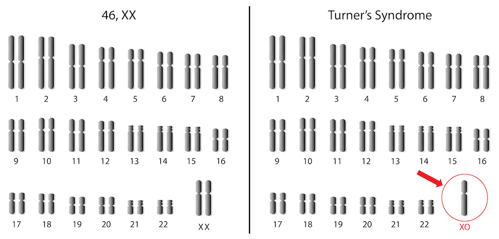
What are the differences between modern vs. older karyotypes?
May 7, 2014

- Related Topics:
- Genetic testing,
- Chromosomes,
- Reproduction,
- Trisomy/Aneuploidy
A curious adult from California asks:
"I had a karyotype performed in the early 1980s to rule out Turner syndrome. How accurate were karyotypes done at that time? If I am having some issues with infertility should I have this test performed again?"
Karyotypes from the 1980’s were definitely good enough to have caught something as obvious as Turner syndrome. Assuming the people who did the test originally did it correctly, a diagnosis of Turner syndrome is not something that would be missed. Today’s technology makes the karyotype testing more sensitive because they are getting better and better at finding small differences.
In Turner syndrome, a woman is missing a whole chromosome -- she has only one X instead of the usual two. Since the 1960’s scientists have been able to see this sort of thing by taking a person’s blood or saliva, pulling chromosomes and DNA from the cells, and looking at them under the microscope. This picture of all of the chromosomes is called a karyotype.
Humans usually have 23 pairs of chromosomes for a total of 46. If you have Turner syndrome, then you would be missing one chromosome from your XX pair and so would have 45 instead. A test from the 1980’s (or even the 1960’s) would have caught that.
Now as I have hinted, this doesn’t mean that the test you had was necessarily done correctly at the time: it only means that the technology for detecting this isn’t any better today than it was then. In other words, looking for Turner syndrome is as reliable now as it was then. So the bottom line is that if the test was done correctly, then your infertility probably can’t be explained by missing an X chromosome.

Other Chromosomal Causes of Infertility
Turner syndrome is not the only chromosomal problem that can lead to fertility problems. Another common one is something called a balanced translocation.
Balanced translocations happen when a person’s 46 chromosomes are packaged in a way different from the usual. Basically these people have two of their chromosomes stuck together.
Around 1 in 1,000 people have a balanced translocation. People with a balanced translocation are perfectly fine—they have all the usual set of genes. But sometimes their kids don’t.
Around 50% of the time, a fetus will get too few or too many genes. Often this means the fetus can’t survive which leads to miscarriage.
A karyotype analysis would almost certainly catch something major like this as well. It is obvious because two chromosomes are stuck together. This type of thing can be picked up just as easy as picking up a missing chromosome.
That leaves open the question of why you might be having trouble getting pregnant. Unfortunately there are many possible explanations besides Turner syndrome or balanced translocations.
Infertility in Women
Right now we don’t understand all of the problems of infertility in men or women. The most common reasons for infertility in women have to do with ovulation. If a woman isn’t making eggs, then she obviously can’t get pregnant. There are many conditions that can affect a woman’s ability to make eggs.
Another set of reasons all have to do with the next steps after egg release. These include problems with the fallopian tubes or with the fertilized egg implanting in the womb.
Another set of problems are genetic. These are subtle differences in the DNA that cannot be seen in a karyotype. To identify these, you need more sensitive genetic tests.
Unfortunately (there’s that word again!) we haven’t yet found all or most of these genetic reasons. This means that genetic testing will not always find the genetic reasons behind infertility.
Infertility in Men
An additional chromosome problem in males is a condition called Klinefelter syndrome. This occurs when a man has two copies of an X chromosome and one Y chromosome instead of the usual one of each. These men are not usually able to conceive.
Another contributor to infertility is a genetic condition called Cystic Fibrosis. This condition is inherited when both the mother and father carry a genetic difference in the CFTR gene. Fertility problems are present in men with cystic fibrosis and not commonly in women.
Men can also have infertility problems because of something called microdeletions in their Y chromosome. Old school karyotypes would miss these but the newer more sensitive ones can often catch them. This last one is a case where today’s karyotypes would catch something the older ones would have missed.
Infertility: The Next Steps
As you can see, there are many ways to cause infertility in both men and women. Once you’ve ruled out chromosomal issues with a karyotype, then the next step is to see a fertility specialist.
Current technologies that are offered for individuals that are experiencing infertility include karyotypes and fertility evaluations. Fertility evaluations can sometimes determine the cause to be either male or female, which could result in further testing. Seeking out fertility specialists could be beneficial in understanding the cause of infertility and also if there is anything that can be done to conceive.

Author: Ashley Navarro
When this answer was published in 2014, Ashley was a student in the Stanford MS Program in Human Genetics and Genetic Counseling. Ashley wrote this answer while participating in the Stanford at The Tech program.
 Skip Navigation
Skip Navigation
